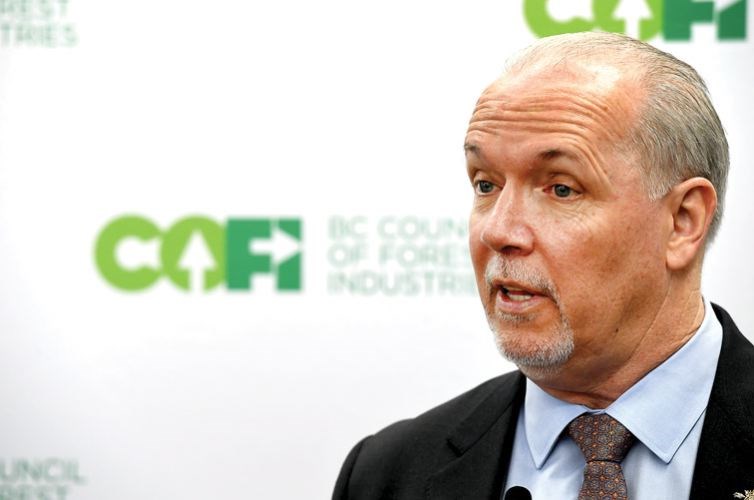Premier John Horgan was pulling for the Powell River Kings in the BCHL playoffs, being a former resident of the general area. He was in Prince George for their defeat at the hands of the Spruce Kings.
What could be better, he said, than the clash of two teams who represent the essence of the core B.C. economy. Paper and lumber, head to head.
And what better place for the epic on-ice game than Prince George during the Council of Forest Industries (COFI) conference - the biggest assembly of the nation's actual forestry kings?
Horgan was the morning keynote speaker at the conference, his first time addressing the hundreds of forestry figures since becoming B.C. premier.
It was his first opportunity to share his vision for the province's backbone industry. He wanted to assure the crowd that despite his NDP government being new to them all, he was focused on maintaining their profitable ways.
Even before he was made premier this past July he had already been to Washington, D.C., to get a personal orientation of the ongoing softwood lumber dispute, and that topic is front-of-mind right now for the wood manufacturing companies of the province, and the communities in which they work.
Expanding foreign markets for B.C. wood was a main takeaway from that visit, and a philosophy already well ensconced in government dealings.
"Over the past 20 years, successive governments of all political stripes have worked very, very hard to diversify our markets," he said. "With the protectionist administration in the United States right now it has never been more important. The good news is that our dependence on the U.S. is down around 55 per cent of our forest products whereas it used to be 80. So we are making progress but we have to work every day to make sure we can get access to markets right around the world. We need to be salespeople for this."
Canadians can also do much more to support the wood industry. Few manufacturing techniques impress and inspire Horgan more, he said, than the engineered wood sector. The cross-laminate and glulam products that turn British Columbia wood into the bones of high-rise structures is the beacon he's following into the future.
"We could be exporting those engineered wood products like pieces of Lego to communities around the world. The future is bright for building with wood. It started here in Prince George and it's expanding right around the province."
Running counter to the hopes of future prosperity is the official amount of wood allowed to be logged from the B.C. forest. Each year that amount is reassessed. That number exploded during the peak of the mountain pine beetle epidemic, as the province raced to maximize the value of the dead trees.
That balloon has been deflated back to regular amounts, and forest companies necessarily had to cut back their level of operations. That translates to fewer jobs for Central Interior communities.
In the Williams Lake area, the Annual Allowable Cut (AAC) was 3 million cubic metres of wood and is set to go down to 1.4 million this coming year. The 100 Mile House AAC is set to drop from 1.9 million cubic metres to 840,000.
Compounding that drop is the reality that wildfires last summer affected a breathtaking 1.2 million hectares of timberland.
It is not yet known exactly how much that will subtract from the region's ability to find trees for milling. And even at the best of times, said Horgan, the AAC was being set based on questionable knowledge of what was actually out there in the bush. Better information from the forest floor could drastically help forest companies keep the best possible flow of wood coming into the mill, making jobs for towns large and small.
"That requires investments in people - public officials or contracted officials to do that type of inventory," said Horgan. "That's the role of government. That has been the role of the Forest Service in the past. We need to revitalize that. There has been a decline in enthusiasm for public service over the years, and I think we need to revitalize that."
More accurate information will lead to more fiscally prudent decisions by both government and private companies. Horgan also said the eyes needed to get sharper on what was being left behind out on the forest floor where harvesting has been done. With all the new wood-based industries coming online like pellets and biomass, with more innovative secondary manufacturing businesses coming online, could more woody debris be brought in from the logging blocks and help boost the fortunes of forest companies and rural residents?
"We need to ensure that this plays out in the interests of communities. I've been working closely with the CEOs of the major companies, and also talking to the smaller operators, that are desperately in need of more fibre," said Horgan.
"Let's ensure that the right logs go to the right places. Veneer plants, OSB plants, they need different quality wood than a two-by-four mill does. And on the pulp side, every time a sawmill goes down, that's a loss of access to chips to make pulp, and that's critical on the coast and it could become critical in the interior as well. I think we can do that even with a reduction in the AAC if we work together."



.png;w=120;h=80;mode=crop)